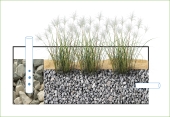Mike Autumn wrote:....since they break down organic matter and absorb excess nutrients from grey water. ...
...does that involve just pruning or uprooting the plants or does it mean taking everything out, cleaning it and/or replacing the substrate?!
Not quite. There is another step. The reefs have a hollow stem. This allows the plant to pull air down and release it from the roots which oxygenates the grew water. Aerobic bacteria can now begin the process of breaking down the nutrients which are then absorbed by the reed for growth. Thus the nutrients are pulled from the water and converted into plant matter.
Once the reed has reached full maturity and stopped growing its intake of nutrients slows down. At this point you want to Harvest the plant to produce mulch or compost and allow the pruned plant to continue growing.
Hope this helps


